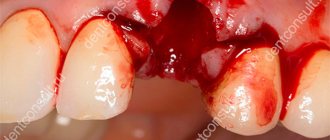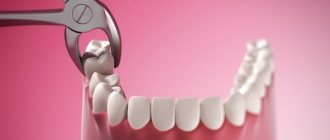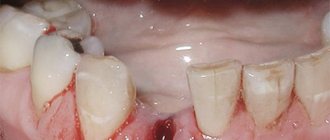Tooth extraction is always accompanied by bleeding, but it usually stops on its own after some time. However, in some cases this does not happen and measures must be taken to forcibly stop the bleeding. There are many methods to stop bleeding - for example, a hemostatic sponge has proven itself well after tooth extraction. Using this product is a simple procedure, but all indications/contraindications must be taken into account.
Features of wound healing after tooth extraction
Before moving directly to hemostatic sponges, what they consist of and how to use them, you need to understand how the wound heals after removal and what can go wrong here. More on this later.
Why is there bleeding after removal?
Bleeding is a natural reaction to surgery. After all, when a tooth is removed, the smallest capillaries that penetrate the gums and ligamentous apparatus - the periodontium, which attaches the roots to the bone socket - are torn. And with difficult removal, the bleeding may be even stronger, because... The dentist makes incisions in the gums and drills into the jaw bone - the tissue is more damaged.
Bleeding is a natural reaction to surgery
Read on the topic: How long can a tooth hurt after extraction - normal and pathological.
How long does bleeding last normally?
Normally, the blood stops within 15-20 minutes (less often, within 45 minutes) and a blood clot forms in the socket. It seals the hole like a cork, preventing germs from penetrating inside. If the patient has problems that affect blood clotting, then the bleeding time is prolonged, and a clot may not form at all. And this is already fraught with inflammation of the bone socket (the pathology is called “alveolitis”). Therefore, according to indications, the dentist applies a hemostatic drug to the area of the extracted tooth.
On a note! Bleeding may appear again for a short time (and there will be quite a bit of blood) after the anesthetic wears off - if it contained adrenaline. This substance narrows the blood vessels in the intervention area, and as they expand normally, slight bleeding occurs. It goes away quickly.
Why does the bleeding not stop for a long time?
As a rule, after tooth extraction, the dentist says that you should not eat or drink for 2 hours. But few people say that you should not rinse your mouth or suck drinks out of a straw. In the first days, only oral baths are allowed, and it is better to drink in the usual way. Also, do not touch the wound with a brush. It is better to chew food on the healthy “side” of the jaw. Otherwise, there is a risk of moving or “pulling” the clot out of the hole - which will provoke new bleeding or even inflammation, which will result in long-term treatment.
The following groups of patients are also at risk:
- who has not formed a blood clot,
- with blood diseases,
- who takes blood clotting medications,
- having high blood pressure,
- women during menstruation or menopause,
- exposing themselves to physical activity immediately after removal and during the recovery process,
- if there was already inflammation at the extraction site (for example, pericoronitis above a wisdom tooth),
- during complex operations: when several teeth were removed at the same time, or manipulations were performed with increased tissue trauma.
Bleeding may occur during physical exertion after removal.
When you need urgent help
If the bleeding is profuse and does not stop for a long time, if after normalization of the condition the blood begins to ooze heavily again, this is a reason to consult a dentist. In a situation where the patient, in the presence of continuous bleeding, feels weakness, apathy, if the temperature has risen sharply (above 39 degrees Celsius), it is better to call an ambulance or go to the hospital on your own.
What is a hemostatic sponge
Now let's move on to why a hemostatic sponge is placed in the hole left after tooth extraction? Let's first understand the terminology. “Hemo” means “blood” and “stasis” means stopping. Those. a hemostatic sponge is needed to stop bleeding. In simple terms, this is a kind of replacement for a blood clot. The hemostatic sponge in the tooth socket not only seals the open cavity, but also has a hemostatic effect. Firstly, it puts pressure on small vessels, stopping bleeding. Secondly, it absorbs excess blood, increasing several times. The bleeding stops within 2-3 minutes.
On a note! By the way, local hemostatic agents are used not only in dentistry, but also in other areas of medicine - for example, hemostatic bandages successfully replace tourniquets that are applied for bleeding.
What it is
A hemostatic sponge is a medical device made in the form of a compact block of porous natural material that looks like a sponge or sponge. A device is used to stop bleeding and accelerate tissue regeneration during surgery.
The product is used as a wound dressing, closing the cavity, keeping the hole sterile and stimulating the formation of a blood clot. Stopping bleeding occurs by absorbing excess blood and wetting the sponge. The sponge increases in size and compresses the walls of the hole, pinching the capillaries.
There are two types of devices:
- Cubes with dimensions 1x1x1 cm.
- Blocks (10x10x1 cm).
The required piece of sponge is cut from the block or cube using scissors or a scalpel. The final shape of the sponge is modeled taking into account the characteristics of the wound and needs.
Appearance and release form
The hemostatic sponge looks like a cube or plate, which looks like a small sponge or a piece of yellow or white foam rubber. Although in fact it consists mainly of natural collagen with various medicinal additives. The plate is quite soft and easy to cut, which allows the dentist to cut the desired size according to the shape of the hole.
The plate is quite soft and easy to cut
Manufacturers produce both small (1x1 centimeter) and large sponges (10x10 cm). The plates are tightly sealed in transparent bags, and the cubes are sealed in dark, opaque bottles. Hemostatic powders and gels are also produced. Absolutely all collagen hemostatics dissolve on their own in the wound over time.
Types of hemostatic sponges
According to the manufacturing method, hemostatic sponges for teeth are of the following types:
- from donor blood plasma - amben,
- from bones/tendons/blood of cattle - collagen and gelatin.
You need to understand that a hemostatic agent not only stops bleeding (due to aminocaproic acid, for example) and stimulates the formation of a blood clot, but also has an antiseptic effect. It can also accelerate regeneration and relieve inflammation. It all depends on the active components that make up the hemostatic sponge. The drug can be impregnated with the following substances:
- antiseptics: chlorhexidine, furatsilin, silver suspension, boric acid, iodoform,
- local anesthetics: for example, lidocaine,
- preparations for bone regeneration: calcium phosphate,
- antibiotics: metronidazole, chloramphenicol, neomycin, gentamicin, etc.,
- natural substances: propolis, eugenol, etc.
Hemostatic sponges for teeth come in different types
What is she?
So, a hemostatic sponge is an effective hemostatic agent, widely used in various medical fields, in particular, by dentists when removing teeth. The sponge has pronounced antiseptic and sorbing properties, and therefore not only stops bleeding, but also protects the wound from bacteria. In addition, thanks to the described remedy, damaged sockets heal faster.
Main types of hemostatic sponges
So, the described remedy is intended not only to stop bleeding, but also to prevent the occurrence of inflammatory processes if a complex surgical intervention was performed (for example, a wisdom tooth was removed). In standard cases of extraction, bleeding is stopped with the help of a collagen sponge that stops the bleeding.
After surgery, if there is a risk of inflammation in the tooth socket, dentists often recommend using “Alvostaz” - this is a special alveolar compress made in the form of a sponge. "Alvostaz" has an antiseptic and hemostatic effect, in addition, the drug is often used for the prevention/therapy of alveolitis.
About release forms
So, what is a hemostatic sponge? Essentially, it is a yellowish pressed powder that has a faint aroma of acetic acid. These sponges are sold in the form of small rectangular elastic plates (their sizes can be 5x5 cm and 9x9 cm) with a porous dry structure. During production, sponges are placed in PET bags, which are tightly closed, and then placed individually in cardboard packaging.
These sponges - just like regular sponges - perfectly absorb liquid, swelling at the same time. Sponges do not dissolve in cold water, as well as in substances of organic origin, but can partially dissolve in water whose temperature is more than 75 degrees. To make pressed plates, a collagen solution is used - it is obtained from the tendons/skin of cattle. There are also additional components - boric acid and nitrofural.
The above-mentioned “Alvostaz” is considered one of the most effective remedies. The product is sold in the form of small (dimensions - 1x1 cm) hemostatic sponges soaked in a special solution, packaged in plastic jars of 30 pieces. "Alvostaz" is produced in three versions; it contains propolis, eugenol, tricalcium phosphate, iodoform, lidocaine and thymol.
Effect of hemostatic sponges
The product described in the article is used locally (it is used to pack wounds) and has a wide spectrum of action, namely:
- stops bleeding;
- accelerates wound healing;
- protects the hole from bacterial infection;
- prevents swelling of gum tissue;
- stops the focus of the inflammatory process;
- eliminates painful sensations.
Note! The hemostatic sponge is effective for several hours after tooth extraction. After a certain time (indicated by the manufacturer), the sponge placed in the hole dissolves completely.
Manufacturers of hemostatic sponges
Popular manufacturers of hemostatic agents used by dentists in our country are domestic companies. Let's consider them further:
- Alvostaz compress from Omega-Dent: available in the form of cubes, flagella, powders and solutions. The compresses are numbered - “1” with iodoform, “2” with metronidazole and chlorhexidine, “3” with neomycin and chloramphenicol,
- "Gemasept" with gentamicin from the Russian Research Institute of Hematology and Transfusiology of the Federal Medical and Biological Agency",
- “Collagen hemostatic sponge” with silver and boric acid from “Zelenaya Dubrava”,
- “Hemostatic sponge” with furatsilin and boric acid from “Belkozin”.
Indications for use
A hemostatic sponge can be useful after tooth extraction, especially wisdom teeth. Because the “eights” often do not erupt completely, and the dentist has to perform a mini-operation to get to them and remove them along with the roots. When a tooth is removed, a hemostatic agent is placed 3-4 months before implantation to completely eliminate the possibility of complications and problems with the formation of new bone in the socket.
Also, hemostatic sponges or powders are used during operations on the gums1 - plastic surgery, curettage of gum pockets (removal of deep “deposits” of tartar), and when cutting off dead areas of the jaw bone due to osteomyelitis. In the latter case, bone blocks and materials for regeneration of bone substance are additionally planted. In general, the doctor always assesses the patient’s condition in advance - asks about diseases and other conditions, and about the medications taken. If there is a risk of bleeding or poor regeneration, then rest assured, a hemostatic sponge will definitely be placed in the hole.
These sponges are used for bone augmentation
It is important to know! A few days after tooth extraction, it may be necessary to apply a hemostatic sponge if the dentist sees a tendency to worsen. For example, a clot has fallen out or the gums/bone have become inflamed.
Application
Hemostatic agents are used locally to pack the wound when necessary:
- Stop parenchymal and capillary bleeding;
- Close the gallbladder bed after surgery;
- Stop bleeding in the bone marrow canals;
- With tamponade of the sinuses of the dura mater of the brain;
- To strengthen the suture of the intestinal anastomosis;
- To strengthen the suture of the vascular anastomosis;
- Get rid of alveolar bleeding in the tooth extraction cavity.
Before use, the package should be opened with sterile scissors and gloves. Then, remove the gelatin plastic and apply it to the bleeding site, pressing lightly for 1-2 minutes. It can also be used after soaking it in saline or antibiotic.
How to use the drug correctly
How to use the sponge? The hemostatic sponge is placed into the socket of the extracted tooth only by the dentist. Home use is not recommended due to the risk of infection deep into the tissues. The application procedure is given step by step below:
- tooth extraction or treatment of the hole a few days after removal: in the latter case, purulent masses are removed, irrigation is carried out with an antiseptic,
- a piece of the hemostatic plate is cut off with sterile scissors or a hemostatic cube is taken with tweezers,
- the drug is placed in the hole and pressed with a flat instrument: if the hemostatic agent is pre-saturated with thrombin, the hemostatic effect is enhanced,
- if necessary, an additional piece of hemostatic is applied,
- if necessary, a small tampon is placed on top of the hole (it will be removed the next day),
- suturing the gums - a seam in the shape of the letter “P”: also, if necessary, in most cases you can do without stitches.
A piece of the hemostatic plate is cut with sterile scissors.
Dental sponge
Dental sponge "Stimul Oss" with chlorhexidine based on hydroxyapatite and collagen is used for filling bone defects and intraosseous implantation, for contour osteoplasty, in the surgical treatment of periodontitis, periodontal disease, etc.
The dental hemostatic sponge “Stimul Oss” is unique. The collagen sponge, in contact with the wound surface, stimulates the growth of connective tissue, i.e. wound healing. Designed to optimize reparative osteogenesis, prevent jaw atrophy after removal of teeth, cysts, benign tumors, sequestration, as well as increasing bone volume (contour osteoplasty) in order to eliminate its deformation and prepare the mouth for prosthetics. It is also used for intraosseous implantation of supports for dentures and surgical treatment of periodontitis and periodontal disease. Dental sponge “Stimul Oss” is a dry porous material with a base in the shape of a circle or square, soft elastic consistency, white color, diameter 11 mm, welding temperature in water is not less than 45.0 ° C; pH of aqueous extract 5.0–7.5; sorption activity no more than 10 minutes; mass fraction of moisture no more than 18.0% Contains: hydroxyapatite, chlorhexidine, formaldehyde. Hydroxylapatite, which is part of the drug, has a stimulating effect on the activity of reparative osteogenesis in the socket of the extracted tooth. Chlorhexidine is introduced to increase antibacterial activity, and the dosage is selected so that it does not reduce the osteoinductive properties of the entire product as a whole. Indications for use:
- After tooth extraction in order to reduce atrophy of the alveolar edge of the jaw.
- After tooth extraction for the purpose of osteoreparation, which allows earlier intraosseous implantation of supports for dentures.
- During resection of the apex of the tooth root for chronic periodontitis, cystogranulomas.
- After removal of jaw cysts (odontogenic and non-odontogenic) and removal of benign jaw tumors (fibroma, adenoma, etc.)
- During sequestrectomy for destructive osteomyelitis of the jaws.
- For radical flap operations for periodontal disease and for filling the periodontal pocket after its curettage for local periodontitis in order to restore the walls of the alveoli.
- When implanting denture supports (to achieve osseointegration).
- For alveoplasty with atrophy of the alveolar process.
- To raise the floor of the maxillary sinus in order to create conditions for intraosseous implantation.
- For contour plastic surgery (hernioplasty, in particular for dentofacial deformities).
The warranty shelf life is 3 years from the date of manufacture. Packaging: double bag made of polyethylene film, combined material or other materials approved for packaging medical products. The product is sterilized upon release by gamma rays at a dose of 1.5 MRAD. Contraindication:
- Polyallergy.
- Allergy to chlorine-containing substances.
- Allergy to collagen-containing drugs.
Instructions for use: After removing a tooth, cyst shell, sequestrum, benign tumor or other pathological tissue, blood clots are removed from the resulting bone defect with a stream of saline solution, a curettage spoon or a gauze swab. After treating the outer surface of the outer package - container with an antiseptic solution (furacilin, chlorhexidine, etc.), it is opened with sterile scissors and the small packaging bag containing a dental sponge is removed with sterile tweezers, the small package is opened with sterile scissors, the GSK-X-GA block is removed with tweezers -50 and inject it into the bone tissue defect. The number of blocks used is determined by the volume of the bone defect. Having ensured hemostasis, the edges of the soft tissue wound over the bone defect are brought together with sutures. After its removal, the tooth socket is filled with 1–2 GSK-Kh-GA-50 blocks to 1/4 of its depth. The edges above the hole are brought together with sutures or applied for 20–30 minutes. gauze swab. The patient is not recommended to eat for 4 hours. With contour osteoplasty and alveoplasty, the periosteum is peeled off from a small soft tissue incision. The resulting cavity (tunnel) is tightly filled with GSK-Kh-GA-50 blocks. The edges of the soft tissue wound are brought together with sutures. STORAGE CONDITIONS "Stimul Oss" in packaging of the enterprise is stored in protected from light, closed, clean warehouses without foreign odors. Manufacturer: JSC Luzhsky, Russia Price: 48.00 rub.
Is it necessary to remove the hemostatic agent?
Patients often wonder what to do with a hemostatic sponge after it has been placed in the socket of an extracted tooth? How long should I keep it on, and will it dissolve on its own? The rules of conduct are as follows: carefully but thoroughly observe oral hygiene, and also take medications prescribed by the dentist. There is no need to specially remove the hemostatic agent - after all, it consists of components that will completely dissolve during wound healing. And instead of a hemostatic agent, its own tissues form in the hole.
“When my wisdom tooth was removed, they stuffed it into the wound like a piece of foam rubber. I then saw the houses through the seams. I was also surprised - what is it? And at the next appointment, my dentist told me that this is a special sponge that absorbs blood and protects against infection. And when it resolved, I didn’t even notice)) It probably completely disappeared in a couple of weeks.”
Ekaterina R., review from irecommend.com
Contraindications and side effects
The only contraindication to the use of a hemostatic sponge after tooth extraction is an individual allergy to any of the components of the drug. In particular, for antibiotics that are used to impregnate the hemostatic agent. Therefore, be sure to tell your dentist if you are allergic and to what medications. Hemostatic agents should also be used with extreme caution in children.
There are no side effects, because There are no toxic substances or components that affect perception in hemostatics. But if itching, inflammation, or swelling appears, feel free to contact your dentist. These manifestations can be caused either by a newly manifested allergy or by incipient complications - if, for example, the treatment was carried out poorly or the patient did not follow the doctor’s instructions.
1Skulean A. Periodontal regeneration, 2012.
Contraindications
The main contraindication to the use of collagen sponges to stop bleeding is hypersensitivity to any components used in their manufacture. In particular, this is intolerance to nitrofuran drugs. With increased sensitivity to them, severe allergic skin reactions are observed, accompanied by severe itching.
Collagen sponges should not be used to stop arterial bleeding. In this case, a tourniquet must be applied and the person must be urgently transported to a medical facility to provide qualified surgical care.
Contraindications to the use of collagen-based hemostatic sponges are skin lesions caused by pyogenic bacteria. In this case, the wound must be periodically treated with antiseptic agents to remove its purulent contents.










